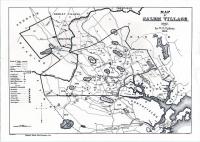Don Shave's Ancestral Family Tree
Salem Village, County of Essex, The Colony of Massachusetts Bay, British Colonial America (North America)
Salem is located at the mouth of the Naumkeag river at the site of an ancient American Indian village and trading center, first settled by Europeans in 1626, when a company of fishermen arrived from Cape Ann Led by Roger Conant, his leadership provided the stability to survive the first two years, but John Endecott, one of the new arrivals, replaced him by order of the Massachusetts Bay Company. Conant graciously stepped aside and was granted 200 acres of land in compensation These "New Planters" and "Old Planters" agreed to cooperate, in large part due to the diplomacy of Conant and Endecott, and in recognition of this peaceful transition to the new government, the name of the settlement was changed to Salem, a hellenized form of the word for "peace" in Hebrew, "shalom" Salem went on to become famous with the witch trials between February 1692 and May 1693. These were a series of hearings and prosecutions of people accused of witchcraft in colonial Massachusetts that resulted in the executions of twenty people, fourteen of them women, and all but one by hanging. Five others (including two infant children) died in prison The preliminary hearings in 1692 were conducted in several towns: Salem Village (now Danvers), Salem Town, Ipswich, and Andover In 1658 when the subject of witchcraft first came to his [Reverend Francis Dane] attention, he came down decidedly against the concept. When John Godfrey was charged with injuring the wife of Job Tyler by "Satanic acts", Dane judged against the probability Around 1680, when Francis Dane was about sixty-five years of age, church members became concerned about his ability to fulfill his role leading the church and requested that a younger minister be sent to them. In January 1682, Rev. Thomas Barnard, a recent graduate of Harvard, arrived. Shortly following Barnard's arrival, Francis Dane's salary was stopped. Dane petitioned the General Court in Boston to have it reinstated. The town complied, but split the salary of 80 pounds a year so that Dane received thirty pounds and Barnard received fifty. Neither man was pleased with the solution Dane had lived in Andover for forty-four years, and he was seventy-six years old when the Salem Witch Trials began. On October 18, 1692, Francis Dane, Thomas Barnard, and twenty-three others wrote a letter to the governor and to the General Court publicly condemning the witch trials. Dane and his family were in danger as half a dozen family members stood accused, including Francis Dane himself. Another minister, George Burroughs, had been hanged, and thus Dane's status did not guarantee protection. He warned that his people were guilty of blood for accepting unfounded accusations against covenanted members of the church Two of Francis Dane's daughters, Elizabeth Dane Johnson and Abigail Dane Faulkner, and his daughter-in-law, Deliverance Dane, were all arrested. Abigail Dane Faulkner's two daughters, Abigail Faulkner and Dorothy Faulkner, were also accused of witchcraft Dane's daughter, Abigail Faulkner Sr., was convicted and condemned in September 1692 but given a temporary stay of execution because she was pregnant. She was later pardoned by the governor and released Although Dane's extended family had the most accused of any family, none of his immediate family members were executed, except Elizabeth Jackson Howe (executed July 19, 1692), wife of James Howe, Jr. (or How). Martha Carrier, Dane's niece was also executed as a witch August 19, 1692 [ see webtags ]
